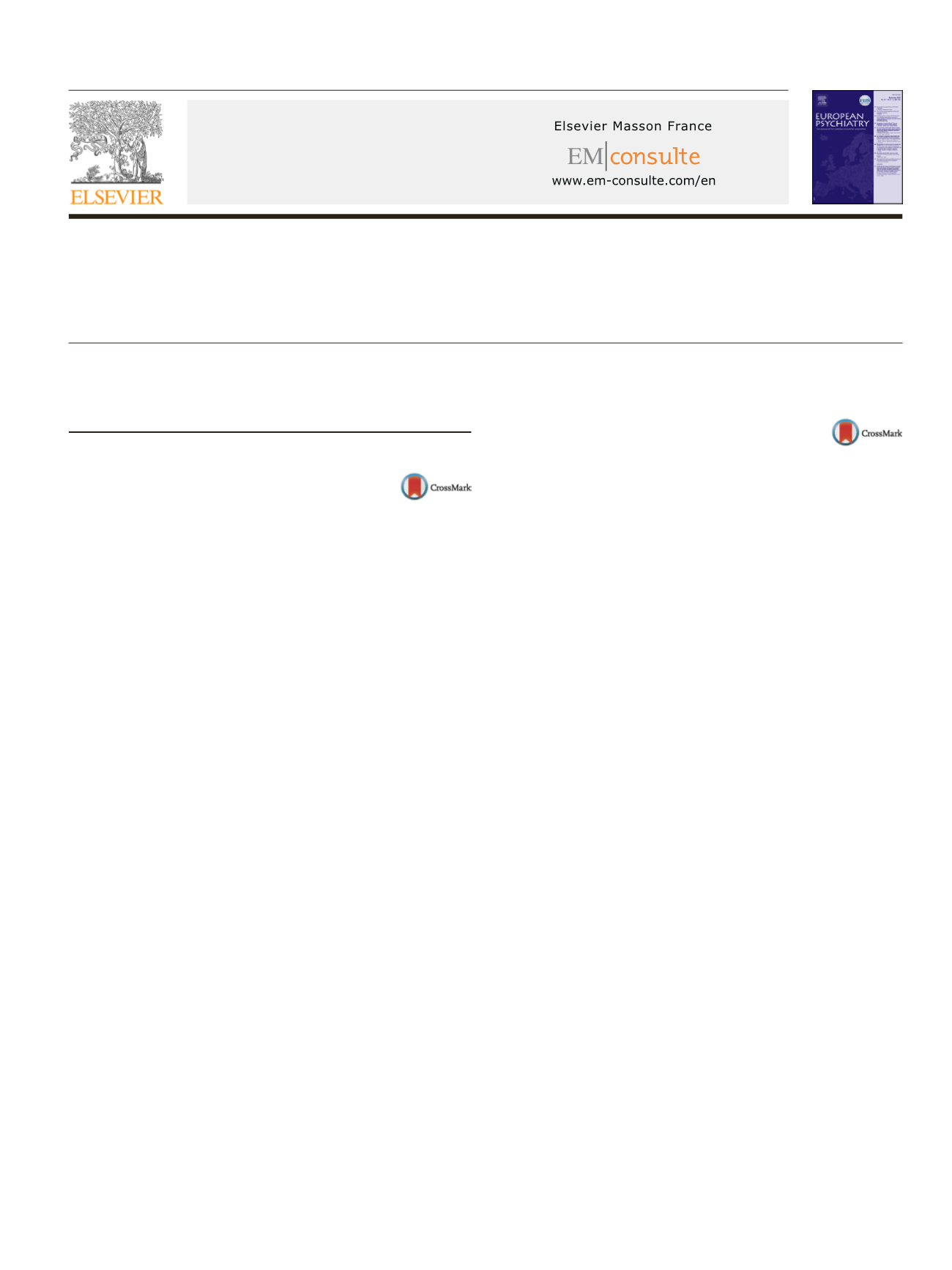
 European Psychiatry 41S (2017) S465–S520
European Psychiatry 41S (2017) S465–S520
Available online at
ScienceDirect
www.sciencedirect.com25th European Congress of Psychiatry
ePoster viewing part 2
e-Poster viewing: Comorbidity/dual pathologies
EV0189
Behavioral disorders in emergencies.
Differential diagnosis and treatment
S.M. Ba˜nón González
1 ,∗
, N. Ogando Portilla
1,
M.G. García Jiménez
1, R. Álvarez García
1, F. García Sánchez
21
Hospital Universitario Rey Juan Carlos, Psychiatry, Madrid, Spain
2
Hospital Universitario de Móstoles, Psychiatry, Madrid, Spain
∗
Corresponding author.
Introduction
The clinical case has been submitted because it
presents a number of difficulties in diagnosis. After seven psychi-
atric hospitalizations, it does not present a definitive diagnosis,
poor prognosis and multiple relapses.
Objectives
Both analyze clinical, psychopathological and epi-
demiological characteristics of behavioral disorders in relation to a
clinical case and review causes, incidence, prevalence, diagnostic,
therapeutic tools and the importance of an appropriate differential
diagnosis to reach a correct therapeutic approach.
Methods
Review of the impact literature for the last five years
concerning behavioral disorders: prevalence, incidence, pathogen-
esis and its relationship with psychiatric disorders encoded in
DSM-V.
Results
It is evident that the patient has behavioral disorders
and psychotic symptoms in the context of cocaine intoxication.
Although sometimes the dose of cocaine has been very small and
probably not justifies in all cases a toxic psychosis, it is true that
withdrawal periods have been short; therefore difficult to assess.
Alsomania-like symptoms have been discussed because the patient
has an increased activity, dysphoric mood, anxiety and decreased
need for sleep.
Conclusions
Response to treatment and hyperactivity, impulsi-
vity and inattention characteristics make us consider the diagnosis
of adult Attention Deficit Hyperactivity Disorder (ADHD). ADHD in
adults and adolescents have significant comorbiditywith substance
abuse, particularly cocaine, amphetamines and psychostimulants,
also alcohol, tobacco and cannabis, and with other psychiatric
disorders: oppositional defiant, personality (especially cluster B:
antisocial, etc), anxiety (generalized anxiety, phobias, panic..),
affective or eating disorders.
Disclosure of interest
The authors have not supplied their decla-
ration of competing interest.
http://dx.doi.org/10.1016/j.eurpsy.2017.01.519EV0190
The connection between drugs of
abuse and personality disorders
Y. Barylnik
∗
, J. Abrosimova , S. Pakhomova , D. Samoylova ,
E. Kolesnichenko , A. Antonova , E. Bachilo , M. Deeva ,
N. Filippova , S. Sizov , A. Paraschenko
Saratov State Medical University, Department of Psychiatry,
Narcology, Psychotherapy and Clinical Psychology, Saratov, Russia
∗
Corresponding author.
Introduction
Patients who are suffering from different type of
drugs have special individual and psychological problems. These
changes are important for regulation and to control their behaviour.
Objectives
To study the psychological characteristics and per-
sonal resources of the patients who are suffering from abuse of
drugs.
Methods
Fifty patients were studied, 63.3% men and 36.7%
women and in the ages of 18–21 years. Following psychodiag-
nostic methods are used: Kettel’s sixteen personality factor test,
Leonhard-Shmishek’s personality test, scale of reactive and per-
sonal anxiety Spielberger-Hanin.
Results
Amount those patients were suffering from different
type of drugs: synthetic cannabinoids-66.7%, 20% were depend-
ent on synthetic cathinone and 13.3% were dependent on opiates
(heroin). According to Leonhard-Shmishek’s scales, the most often
of personality disorders were dysthymic type, hyperthymic type
and explosive type. According to Kettel’s scale were indicated
the leading individually-psychological properties in more than
half of the subjects is the development of abstract thinking, free
thinking, impulsiveness, lack of confidence to the authorities, the
high emotional tension, emotional instability and irresponsibil-
ity. An analysis of global factors indicative of the severity indices
of extraversion. According to Spielberger-Hanin’s scale, 80% of
patients with substance abuse had mild level of situational and
personal anxiety, which can be identified as an important psy-
chotherapeutic resource.
Conclusions
According to scales, the most often of personality
disorders were dysthymic type, hyperthymic type and explosive
type. Eighty percent of patients with drug abuse had mild level of
situational and personal anxiety. This feature is main of predictor
as an important psychotherapeutic resource.
Disclosure of interest
The authors have not supplied their decla-
ration of competing interest.
http://dx.doi.org/10.1016/j.eurpsy.2017.01.520 http://dx.doi.org/0924-9338


















